In a potentiometer, I often see the 3rd leg connected to ground.
I understand exactly what a potentiometer is physically (a wiper along a log or linear resistance), but I don't understand the benefit of connecting that 3rd leg to ground.
In a potentiometer, I often see the 3rd leg connected to ground.
I understand exactly what a potentiometer is physically (a wiper along a log or linear resistance), but I don't understand the benefit of connecting that 3rd leg to ground.
Using the third leg turns the rheostat into a potentiometer. The whole thing acts as a voltage divider, with the moving wiper varying the ratio between the two resistances connected to the differing voltages.

simulate this circuit – Schematic created using CircuitLab
A 3 terminal pot used with 3 terminals, is basically just a voltage divider. As you move the wiper, you increase one resistor in the voltage divider, while decreasing the resistance in the other. So a 3 terminal pot is a variable voltage divider.
But each section of the voltage divider can be considered to be an infinite number of resistors in series such that the total sum is the pot full scale resistance.
Now if we use this infinite resistor model, if you connect one leg of the pot and place in somewhere in within this infinite set, that means we have shorted out those resistors. The total resistance from end to end is no longer the full scale pot resistance (because we have shorted out some of those "resistors".
Connecting a wiper to one leg of the pot, is a rheostat. A rheostat is a variable resistor.
You don't have to connect one the wiper to ground. So long as the wiper is connected to one leg of the potentiometer, it will behave a variable resistor.
Although it didn't quite make sense to me at first, i stumbled upon this page that gives information about voltage dividers. Sparkfun : Voltage dividers
Since a potentiometer consists of two resistors, just like the most basic voltage divider you see (two or three resistors along a wire, they cut voltage each time) it can be used as a voltage divider.
It makes more sense if you study the basic voltage divider before the actual potentiometer.